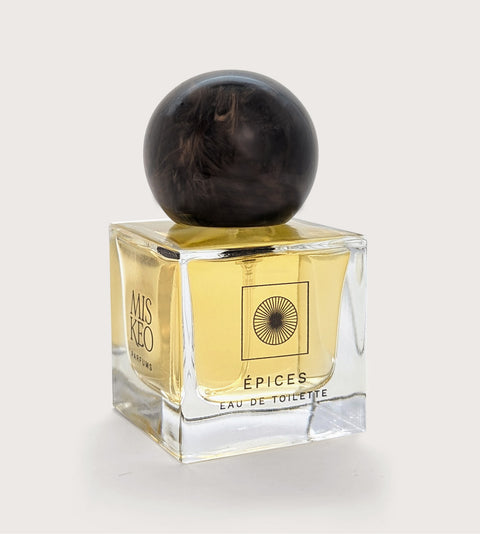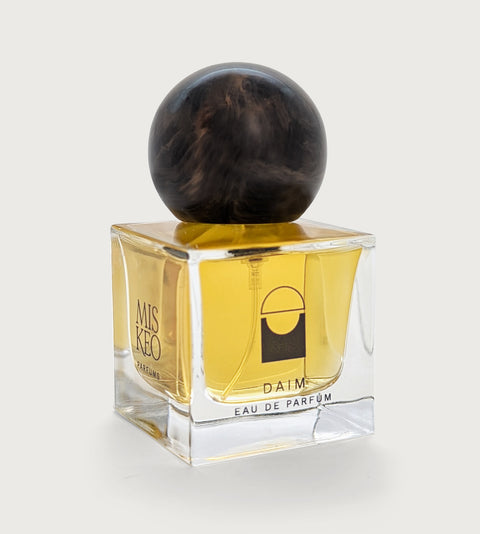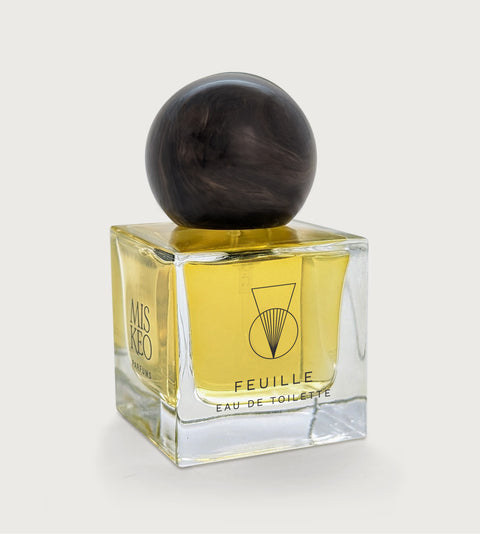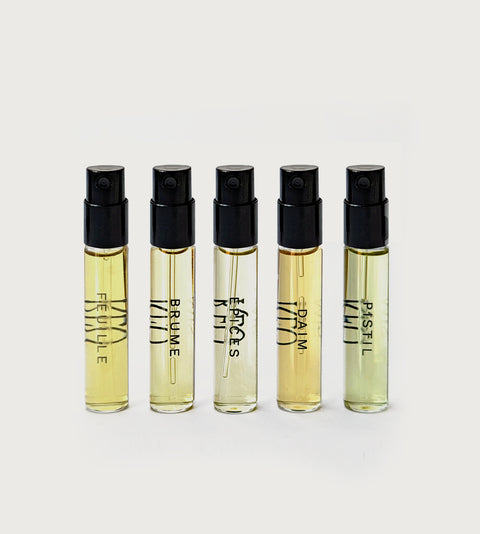Scent Families
Describing and making sense of how we perceive scents is not so easy, so a fragrance wheel to represent scent families comes in handy.
Fragrance wheels are a visual representation of a taxonomy of scent to address commonalities in perception and provide language to articulate abstract sensations. In our interpretation, we imagined 8 scent families, each one moving slightly into its neighbor - there are no hard limits to the families, rather a scented gradient.
For reference, Michael Edwards's and Mandy Aftel's are two other great examples of fragrance wheels.
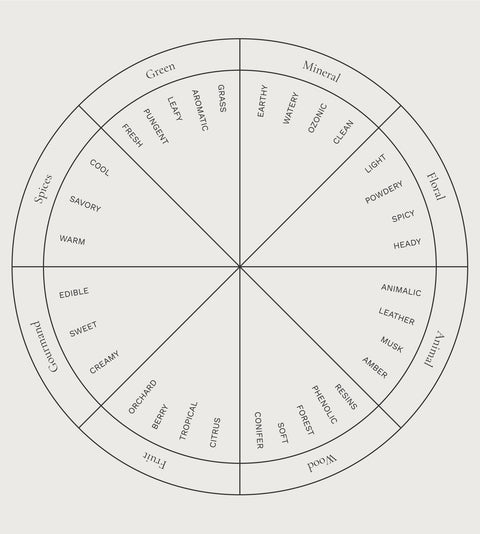
We all gravitate towards certain scent families more than others, and your natural affinities compose a sort of scent profile. Do you love roses, peonies and violets? Perhaps you are a Powdery Floral perfumista. Or maybe you can't get enough of seaside breezes and thunderstorms? Then your profile leans towards Mineral ozonic.
Read on to discover which families your nose prefer.
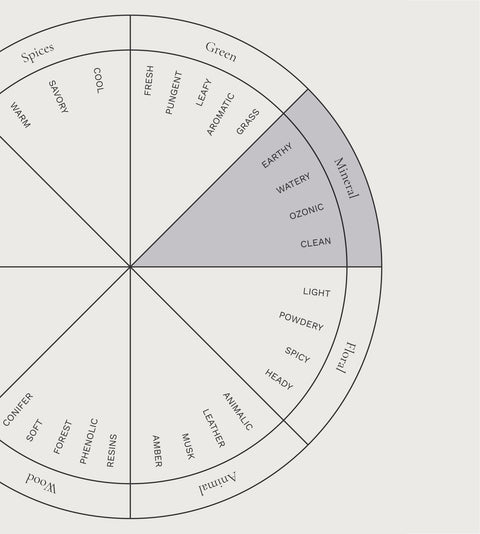
Mineral
Whilst it might not be exactly the right word to describe these scents, the Minerals have at their core the earth in its abstract and more intangible form.
∙ Earthy notes refer to the scent of soil and mushrooms, cold sand and clay. Vetiver can remind us of wet soil while keeping a light profile, while Geosmin takes us to a cold damp cellar.
∙ Even with the absence of scent in water, Watery notes evoke the scent of lake water, a jungle waterfall or a cave, fresh snow. Violet leaf absolute, Calone and Maritima all share wet facets whilst they have vastly different scent profiles.
∙ Ozonic notes smell like metallic-mineral saturated air, like the ocean breeze, a city after a thunderstorm, even like a toolbox. Few molecules can boast such a profile, rather assemblage of materials can produce that effect.
∙ Clean notes capture the effect of a mountain breeze, the scent of laundry drying in the sun, even maybe a little bit like pebbles or wax. Materials known as Aldehydes could be classified here, as well as some white muscs such as Habanolide and Helional
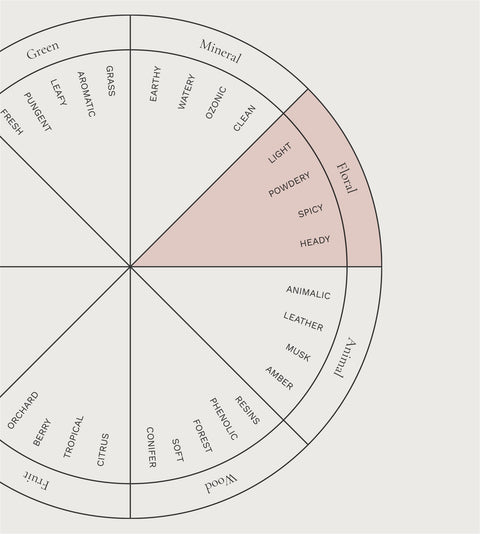
Floral
This group ranges from abstract transparent materials such as Hedione, to romantic pastel-hued blooms like the classic Rose, to mouthwatering peachy-leathery Osmanthus, to almost animal-like sexy white flowers such as Orange blossom.
∙ Light Florals refer to airy, tea-like, sparkly and somewhat green qualities of flowers like Muguet, Geranium, Linden blossom as well as Hedione.
∙ Powdery Florals evoke more tactile feel or texture, and a volume that wraps around sharp edges like Rose, Peony, Violet, Lilac, Orris notes and the lipstick-like molecules Ionones and Irones.
∙ Spicy Florals feel almost edible, with gourmand notes of honey, fruits and spices like the core notes of Immortelle, Lilies, Acacia, Osmanthus, Chamomile or Carnation.
∙ Heady Florals group together rich and intense, sometimes heavily indolic notes you can find in Jasmine, Champaca, Tuberose, Frangipani, Orange blossom and Boronia.
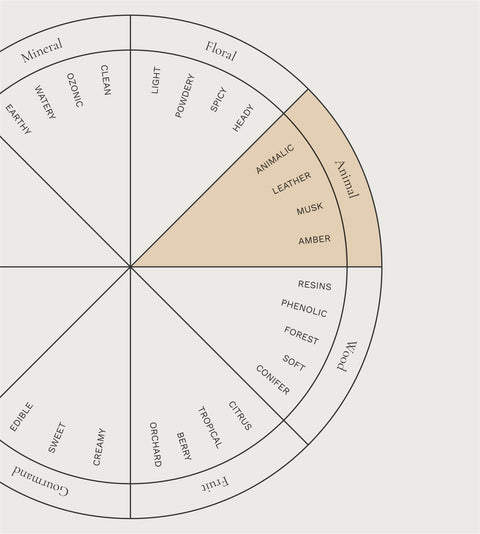
Animal
These notes can be challenging to some when dominating an accord, but if blended carefully they can not only add warmth and lift, they can also make us feel like our favourite perfume is giving us a hug. Because they resonate with our deep instincts and sometimes scream of sex, an overdose could theoritically cause a scene such as the ending of Patrick Süskind’s novel Perfume (probably not, but be warned).
∙ Animalic notes can be quite polarizing, for some the body odours and barnyard scents of Civet, Indole or certain oudhs can be repulsive, and for others really sexy
∙ Leather notes compose the most straightforward group, and raw materials range from green and grassy Iso butyl quinolene to soft and creamy Suederal
∙ Musk notes have many facets, some I could describe as smelling like kitten’s fur like in Costus, or the room where your lover is asleep in Muscone or Ambrofix.
∙ Amber notes have unfortunately recently been abused by overdose of high-strength molecules like Ambrocenide, nonetheless the glorious honeyed and sticky Labdanum, as well as Benzoin and Kephalis remain favourites of Miskeo.

Wood
This scent family can seem at first quite homogenic, but once you dive deeper in its root system or magnify the rich details of the understory, you can only be amazed by the diversity of the scentscape.
∙ Resins such as Frankincense, Myrrh and Opoponax have been traditionally used as incense and sacred offerings, and range from toffee sweet notes to the acrid terpenic notes of conifers.
∙ Phenolic notes are sometimes evocative of campfires and log cabin vibes, or veering towards petrol, tar and meat. Most common notes and materials include Cade, Birch tar, and Guaiac wood.
∙ Forest notes recall the overall effect of a patch of trees in all its glory - the hardy mosses, the gracious ferns, the fragile web of living and dead things composing this ecosystem. Oakmoss absolute is the most well-known material of this group.
∙ Soft wood notes such as Cedar, Cabreuva, Sandalwood and Iso e super create cosy atmosphere that remind us of our homes - the vintage furniture, the shed workshop, the sticks you collected as a kid.
∙ Conifer notes such as Pine, Fir, and Spruce might call on Holiday season for most northern hemisphere westerners, while Hinoki and Cypress might bring you back to your Japanese onsen getaway or your Tuscan vacation. All create a sensation of fresh crispness, and a certain cooling effect.

Fruit
This family might feel a bit cliché and reserved for mall perfumes aimed at teenagers, but used in a subtle and intelligent manner, they can lift, brighten or deepen an otherwise too serious or pompous fragrance.
∙ Citrus notes certainly need no introduction, being major building blocks of modern perfumery. Even though not extracted from citrus fruits, Petitgrain and Lemongrass are as bright as a fresh slice of lemon, while Neroli and Litsea Cubeba have a juicy floral quality shared with Bergamot.
∙ Tropical fruit notes evoke the sunny, rich and complex scent landscape of hot climate sweetness, from tart Pineapple, to floral Lychee, ripe Guava, piney Mango and sticky Dates.
∙ Berry notes are somewhat in contrast with their warm weather counterparts and cast a certain cool darkness - Black currant has an intense green tangy almost-like-cat-pee dominant note, Grape notes always feel a little boozy and Strawberry kind of too decadent, while Raspberry notes have kept close company to violet, wood and leather accords with their insolent splash of dark red tones.
∙ Orchard notes pick up on the woodiness where the berries left off, in addition to crisp or creamy, dry or juicy facets that lead towards the neighbouring family of Gourmand. The most common notes are those of Cherry, Peach, Plum, Pear and Apple.

Gourmand
The GOURMAND scent family has had ups and downs, and maybe too many sweet or boozy headache-inducing nightmares. Still, we have a soft spot for a comforting vanilla or a tender milky note, perfect for colder weather.
∙ Creamy notes have texture AND scent, ranging from beachy Coconut to Dairy notes, then bordering on sweet with sticky caramel. They have a smooth caressing embrace and a childhood comfort to them.
∙ Sweet notes sound more straightforward, but a good perfumer, same as a good cook, will know to pull from different sources: animalic and herbal Beeswax, sultry Maltol, Immortelle-like Maple syrup, coumarinic Tonka, and of course, Vanilla (no introduction needed).
∙ Edible gourmand notes are simply food stuff smells mainly not characterized by other scent families. You can find in here bready or nutty scents, rich chocolate or coffee aromas, and boozy rum and whiskey.
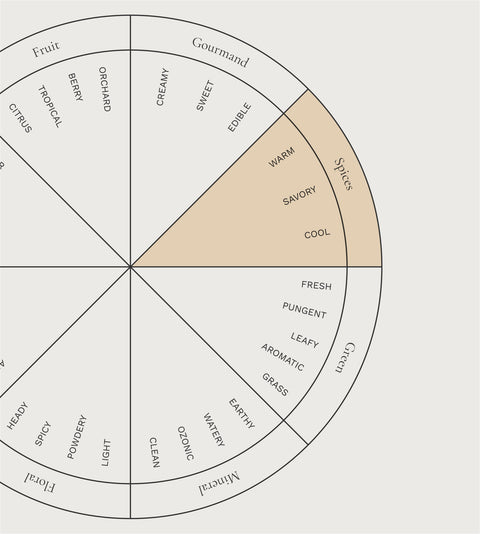
Spice
This scent family is probably our favourite based on how much we sneak these raw materials in each formula no matter the concept, and seeing how obsessed we are with hunting down the good stuff for cooking.
∙ Warm spice notes are so intertwined with the neighbouring Gourmand family that it’s almost impossible to separate their distinct profile from sudden hunger: Clove, Cinnamon, Nutmeg, Allspice, Ginger - all bringing up deep childhood memories of someone cooking something nice for you. In perfume, Clove especially has been a go-to ever since the Carnation accord genre was made popular.
∙ Savory spice notes are perfume’s fireworks, bringing in burst of colours and festive sparks, with materials such as Turmeric, Black pepper, Saffron, Fenugreek, Cumin. They can easily overwhelm but nonetheless have die-hard fans and masters (Hello Mr Sheldrake, Mr Ellena).
∙ Cool spice notes are like special effects, playing with sensations almost more than an actual scent. Coriander seed, Pink pepper, Sichuan pepper, Cardamom, and Anise can sketch frosty or watery landscapes, and if used sparingly will create a kind of refreshing trompe-l’oeil.
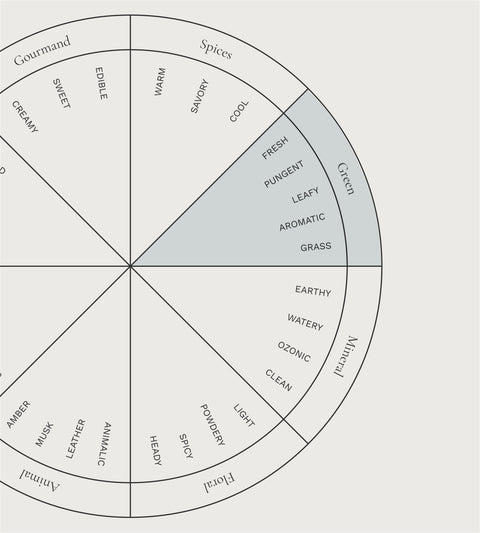
Green
The final scent family on the wheel and the one that inevitably evokes naturalness. We bet our ancient monkey brains have evolved to deeply relate to these scents, once our homes and forever a symbol of vitality and nourishment.
∙ Fresh green notes cross over from the neighbouring cool spices with added refreshing mentholic and camphoreous aspects. Most common materials and notes are Fennel, Juniper, Artemisia, Mint, Myrtle, Basil, Tarragon.
∙ Pungent green notes are usually best smelled in low concentration. Though the materials are usually quite potent - Thiazoles, Iso butyl quinoleine, Rose oxide to name a few, they can bring the perfect "imperfect" nuance to increase naturalness in green compositions.
∙ Leafy green notes evoke lush and bountiful gardens and work up our appetite for earthly pleasure with materials such as Stemone evoking sticky figs or Galbanum a flowering tomato plant. Other materials include vegetal Mastic, verdant Cis-3 hexenol and crisp Shiso leaf.
∙ Aromatic green notes paint a Mediterranean landscape or recall a witch’s kitchen, and build depth and tone in perfumes similarly to their usage in cooking (or spells). Angelica, Thyme, Lavender, Carrot seed, Sage, and Lovage have been essentials to the perfumer’s palette, and have been key in creating iconic fragrances.
∙ Grass green notes bring warm and dry facets to this buoyant family, as well as a touch of sweetness with materials such as Tea, Clary sage, Mate, Tobacco, Coumarin, Hay and Wormwood. They evoke both cosy interiors and summer fields bathed in sunlight, a play on dark and light contrasts.

